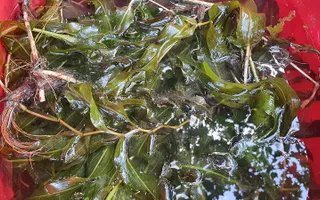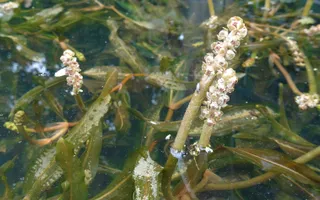Read this page in Welsh / Darllenwch y dudalen hon yn Gymraeg
Exploring the hidden gems of Montgomery Canal: the enigmatic pondweeds
Nestled in the heart of Montgomeryshire, the Montgomery Canal has long been a tranquil haven for nature enthusiasts, offering a myriad of fascinating aquatic life.

Among the diverse flora that graces its serene waters, the Potamogeton, commonly known as pondweeds, stand out as remarkable specimens. These submerged aquatic plants play a crucial role in the delicate balance of this thriving ecosystem, captivating scientists and conservationists alike.
Potamogetons, part of the family Potamogetonaceae, are a genus of aquatic plants comprising over 100 species worldwide. Known for their submerged or floating leaves, they thrive in freshwater habitats such as lakes, ponds, and slow-flowing rivers. These plants serve as vital contributors to the aquatic environment, improving water quality, providing shelter for aquatic organisms, and acting as a primary food source for waterfowl and fish.
The Montgomery Canal, with its extensive network of waterways and wetlands, offers an ideal habitat for Potamogetons. The canal's slow-moving waters, rich in nutrients and sunlight, create the perfect conditions for these plants to flourish. Additionally, the canal's historical significance as a transportation route has played a role in shaping its biodiversity, providing an environment where these rare pondweeds can thrive.

Among the Potamogeton species found in the Montgomery Canal, two particular species stand out for their rarity: Potamogeton praelongus and Potamogeton friesii. Potamogeton praelongus, commonly known as the long-stalked pondweed, possesses long, slender leaves and delicate flowers that add a touch of elegance to the water's surface. Meanwhile, Potamogeton friesii, or Fries's pondweed, is a fragile species with narrow, translucent leaves that create a captivating visual spectacle beneath the water.
These two pondweeds are considered rare and have faced challenges in their survival due to various factors. Human activities, such as habitat destruction, water pollution, and the introduction and spread of invasive species, have taken a toll on their populations. The Montgomery Canal's protected status has provided a haven for these elusive species, allowing them to persist and maintain their ecological significance, however their populations are still small. In recent decades, the ecosystem of the canal has undergone transformations that have led to a decrease in the availability of suitable habitat for certain plants. In order to counteract further environmental changes that hinder the survival of these plants, the Trust and its partners are actively engaged in the restoration of the Montgomery Canal. One of our objectives, alongside reintroducing restricted levels of navigation, is to safeguard the ecosystem and create conditions that allow the plants to flourish once again.

In collaboration with The Rare British Plants Nursery located in Builith Wells, Wales, the Trust is conducting a comprehensive study of these pondweeds. The primary objective of this research is to assess how easy it is to propagate these species which will help contribute to species recovery initiatives worldwide. These particular species of pondweeds are not only rare but also inadequately documented within the UK and on a global scale. P. friesii, for instance, is listed as "Near threatened" on the UK IUCN Red List, having experienced a significant decline of over 20% from the pre-1930s period to 2019. This places it in close proximity to qualifying for a threatened category in the foreseeable future.
Conducting research on the propagation of Potamogetons, including the rare P. praelongus and P. friesii, holds immense importance for several reasons. Firstly, understanding the life cycles, reproductive mechanisms, and ecological requirements of these plants enables scientists to develop effective conservation strategies. By identifying and mitigating the threats they face, we can ensure the long-term survival of these delicate species and maintain the biodiversity of the Montgomery Canal.

Furthermore, the propagation research of Potamogetons can contribute to broader ecological restoration efforts. As aquatic plants play a vital role in water purification, their reintroduction can help improve water quality and restore degraded ecosystems. Additionally, by cultivating a better understanding of their growth patterns and habitat preferences, scientists can enhance the overall management of freshwater habitats, benefiting numerous species that rely on these environments for survival.
Potamogetons, the enchanting pondweeds of Montgomery Canal, offer a captivating glimpse into the hidden wonders of our aquatic ecosystems. Their presence in the canal underscores the importance of protecting and preserving fragile habitats. The rarity of species such as Potamogeton praelongus and Potamogeton friesii highlights the need for dedicated research on their propagation. By studying these plants, we unlock valuable insights into the delicate balance of aquatic ecosystems and pave the way for effective conservation measures. Let us cherish the beauty and significance of these submerged gems, ensuring their legacy endures for generations to come.
Last Edited: 9 August 2024


Stay connected
Sign up to our newsletter and discover how we protect canals and help nature thrive


